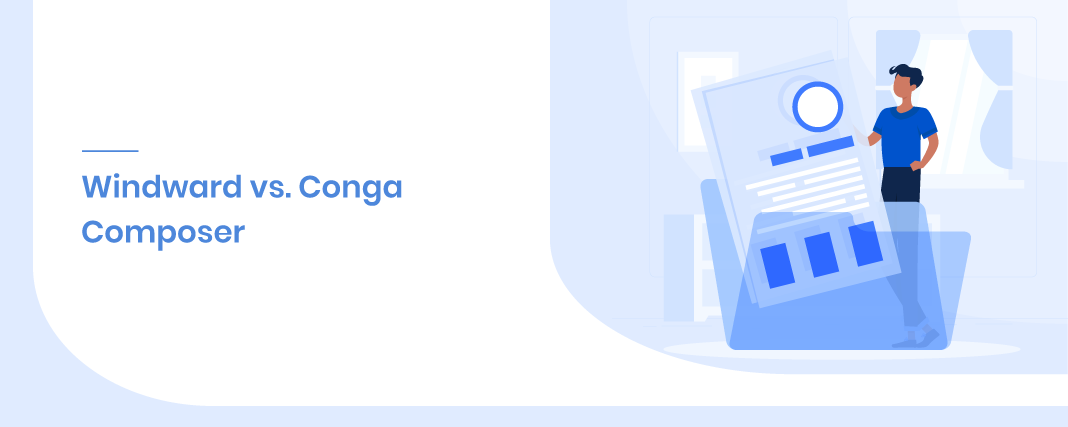In your quest to find the best document generation tool for your rising documentation needs, you would have heard Windward and Conga Composer by now.
Windward helps you create stunning, data-powered documents in no time, whereas Conga Composer makes it easy for you to develop and deliver sophisticated documents from Salesforce. Both being a huge name in the DocGen industry has emerged out to be leaders with their unique offerings. That being said, it is quite overwhelming when you need to choose among these. However, in-depth insight into both might help!
Here, we will run a side-by-side comparison of Windward and Conga Composer to help document generation seekers opt for the best-suited tool.
Windward vs. Conga Composer: A Rundown On Their Peculiarities
1. Creating Templates
To make document generation easier and faster, you require creating a template, and that is what you must look forward to while choosing a document generation solution.
The good news here is that both Windward and Conga makes document creation easy-breezy to a great extent. While Conga’s template builder lets you insert data fields using arrow buttons, Windward eases it a bit with its drag-and-drop functionality. Moreover, Conga has got a template manager that enables you to store, access and centralize all your templates for easy retrieval.
2. Query Builder/Wizard
Queries play a crucial role while building complex documents. Conga has its Query Builder, where you can write queries to fetch specific data. You can write queries in Salesforce Object Query Language (SOQL) SELECT statements, and also poses an alternate if you don’t know the language. Windward comes with Query Wizard, wherein you simply need to drag and drop the field or value, and it will automatically generate queries.
Besides, inserting conditional statements like IF in queries limits you to the functionalities of MS Office while using Conga. On the contrary, Windward comes with a tag tree that supports 16 different tags to leverage while generating complicated documents.
3. Parameters/Behaviors
Customization is the key to any software you purchase. Document generation tools also withstand this. With Conga Document Automation Wizard, you can set several parameters and customize the way you want the solution to retrieve data.
Well, most DocGen tools have a way to pass parameters; what you must focus on is its ability to set parameters, and all the data types you need.
4. Validation, Error, and Warning Handling
When you are creating documents with Conga Composer, and something goes wrong, it will leave you mad finding out what exactly has gone wrong. Undoubtedly, they provide a lot of support to resolve your queries, but that sometimes translates to a vast number of options to navigate when troubleshooting.
Perhaps, this is not the case with Windward. It is power-packed with validation, error, and warning handling mechanisms. Right from validating templates to listing errors and warning on test generation, Windward helps you get a knack of the entire process.
5. Word Form Fields
Many times, you need to create documents with checkboxes, drop-down lists, or other form fields. While Conga Composer and Windward both work with MS Word, you might find it easy to generate documents with the above-mentioned fields. But when you need to have the end result in the form of a PDF, does your DocGen tool provide it?
Unfortunately, Conga Composer fails. It does not support word form fields. Nevertheless, you can successfully work with word form fields with Windward. Moreover, it lets you set their values from your data.
Windward vs. Conga Composer At A Glance
| Features |  |
 |
|---|---|---|
| Applications |
PDF HTML Word Excel PowerPoint |
Word Excel PowerPoint |
| Datasources | It works seamlessly with Salesforce | It works with a wide range of datasources, including Salesforce, MS Dynamics, JSON, OData, SQL, and XML |
| Output Formats |
PDF Word Excel |
Everything including direct output to a printer |
| IF Statements | Limited to MS Word’s functionality | Advanced |
| Code Behind | You must know SOQL statements | No code behind |
| Drag and Drop | Basic | Advanced |
| Import Templates | You can add up to 10 pre-existing templates in a Solution | Advanced |
| Pros & Cons |
|
|
Summing Up
While Congo Composer is the best bet to make if you work in the Salesforce environment, you might face certain challenges while working with other datasources. Besides, Conga simplifies your form creation needs by helping you create a variety of forms, which might be a limitation for Windward.
If you or your team are a novice to document generation system, we recommend opting for a solution that requires less to no technical knowledge. On the one hand, where Conga Composer comes with “no code-behind” ability, on the other, it requires you to have some knowledge for SOQL statements. But, this isn’t the case with Windward.
Though Conga Composer and Windward makes document generation faster, both vary with their functionalities. While Conga Composer comes with a range of add-ons like Batch, Trigger, Mail Merge, and QuickMerge to suffice all your document automation needs, Windward stands out as a comprehensive end-to-end solution.
To decide which one suits your needs the best, you can check out Windward review and Conga‘s detailed reviews.
Need Any Technology Assistance? Call Pursho @ 0731-6725516




